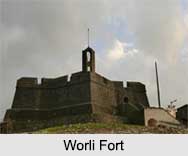 Worli Fort is an ancient fortress constructed by the British around 1675 for precautionary and defence purpose. One of the forts built during the colonial era, it was established on the Worli Hill overlooking the Mahim Bay, at the time when merely seven islands made up the city of Mumbai. It stood at a strategically important place from where the British Navy could spot the vessels and pirates approaching the western coast of British India. It is often mistakenly referred to have been built by the Portuguese.
Worli Fort is an ancient fortress constructed by the British around 1675 for precautionary and defence purpose. One of the forts built during the colonial era, it was established on the Worli Hill overlooking the Mahim Bay, at the time when merely seven islands made up the city of Mumbai. It stood at a strategically important place from where the British Navy could spot the vessels and pirates approaching the western coast of British India. It is often mistakenly referred to have been built by the Portuguese.
History of Worli Fort
Worli Fort is a lesser identified historical landmark in Mumbai. It is said to have built by the British in 17th century as a watch out for the rival ships and pirates. An alternate description suggests that it was built by the Portuguese in the 16th century. In spite of overlooking the Mahim Bay at a time when Mumbai was just a group of islands, the fort was of great planned significance to the British Navy guarding the western coast of the country.
The fort was built in well, a temple and ample of space to soak in views of Mahim, Bandra. This fort is among the three that overlook the Mahim Bay on Mumbai"s western coast, with Mahim Fort and Bandra Fort to its north. All the three forts were adjusted by the British to boost up the defence along with the coast. The fact that the Fort was built with special care could be made out from the well-built structure of the fort that has survived the vagaries of nature. The architecture of the Fort is revealed in the beautifully ornamented gate that leads to the entrance of the fort.
The fort is in the middle of the Worli Fishing Village that makes it quite inaccessible. The Government has not taken any steps to restore the fort from its natural demise, despite the historians, for whom the fort is a special attraction for enhancing knowledge, and a non government organization who have often called for the revival of the fort back to its old glory. The only ray of hope is the new Bandra-Worli Sea Link that skirts around the Worli peninsula, bringing the fort back into the public eye, which can hopefully lead to some action from the Government.
Visiting Information of Worli Fort
Nearest airport to Worli Fort is Chatrapati Shivaji International Airport, 9.2 kilometres away. Nearest railway station is Chhatrapati Shivaji Terminus, 9.5 kilometres away. Regular buses are available easily.



















